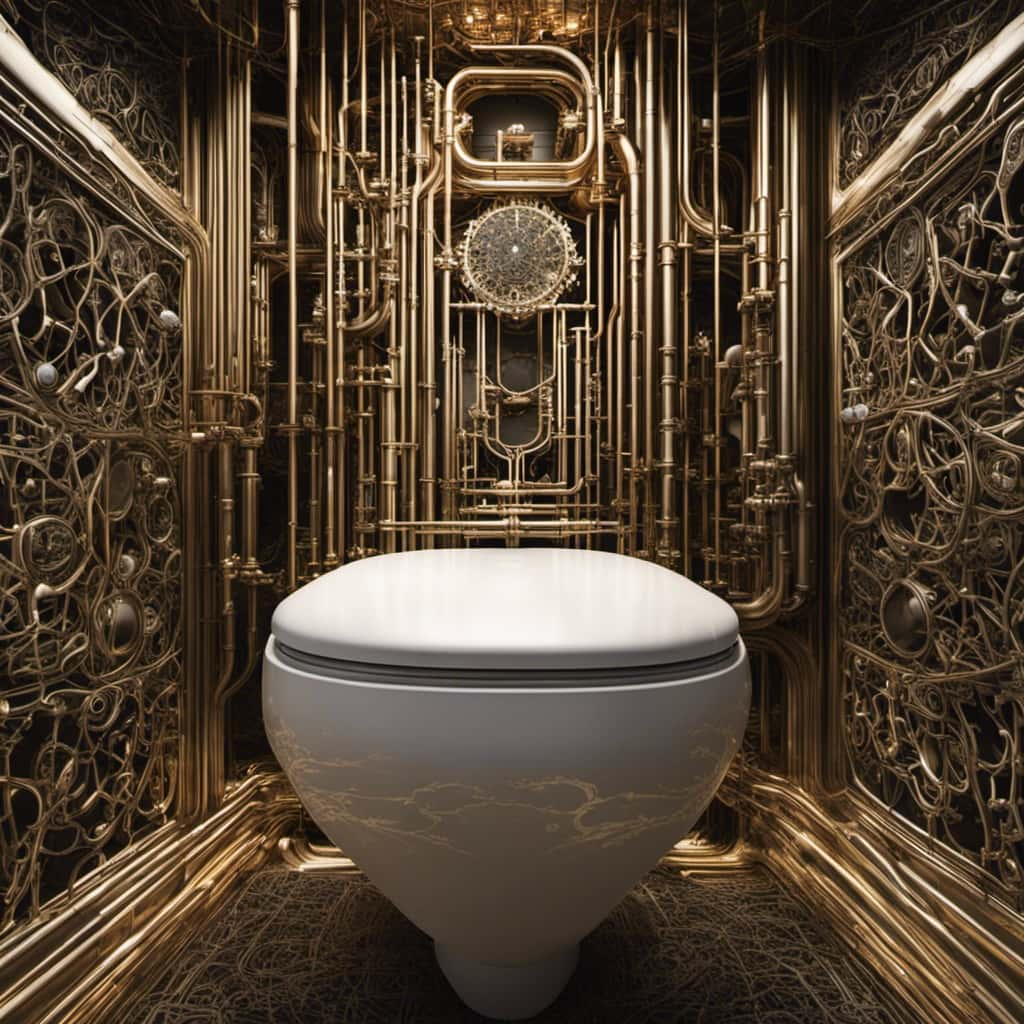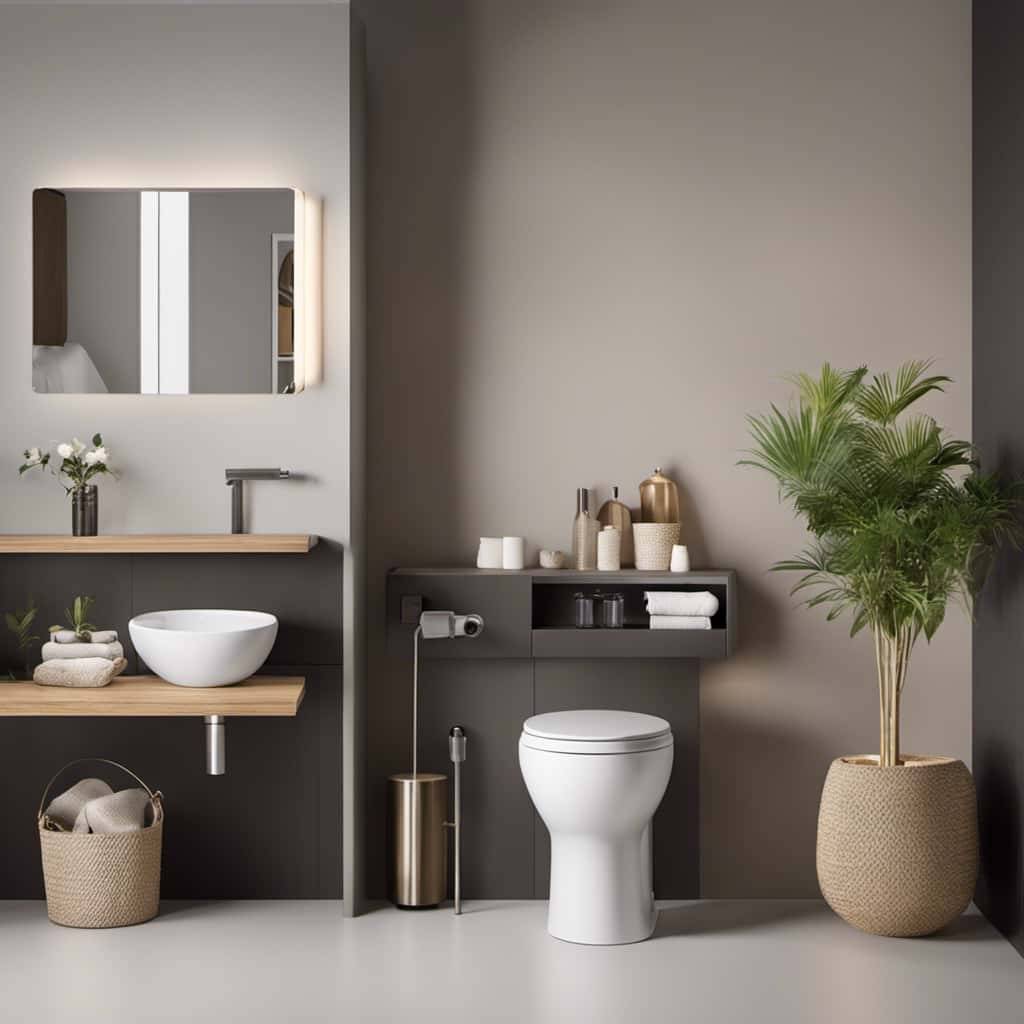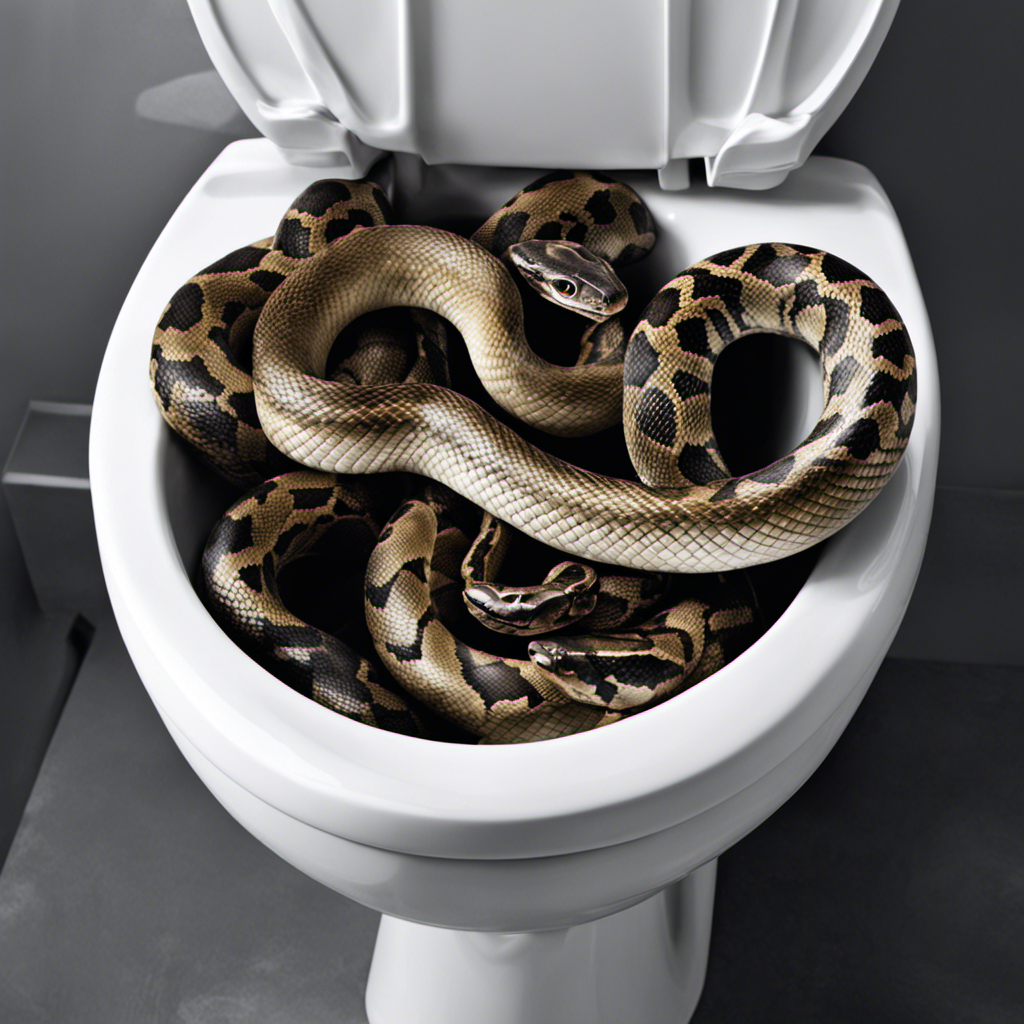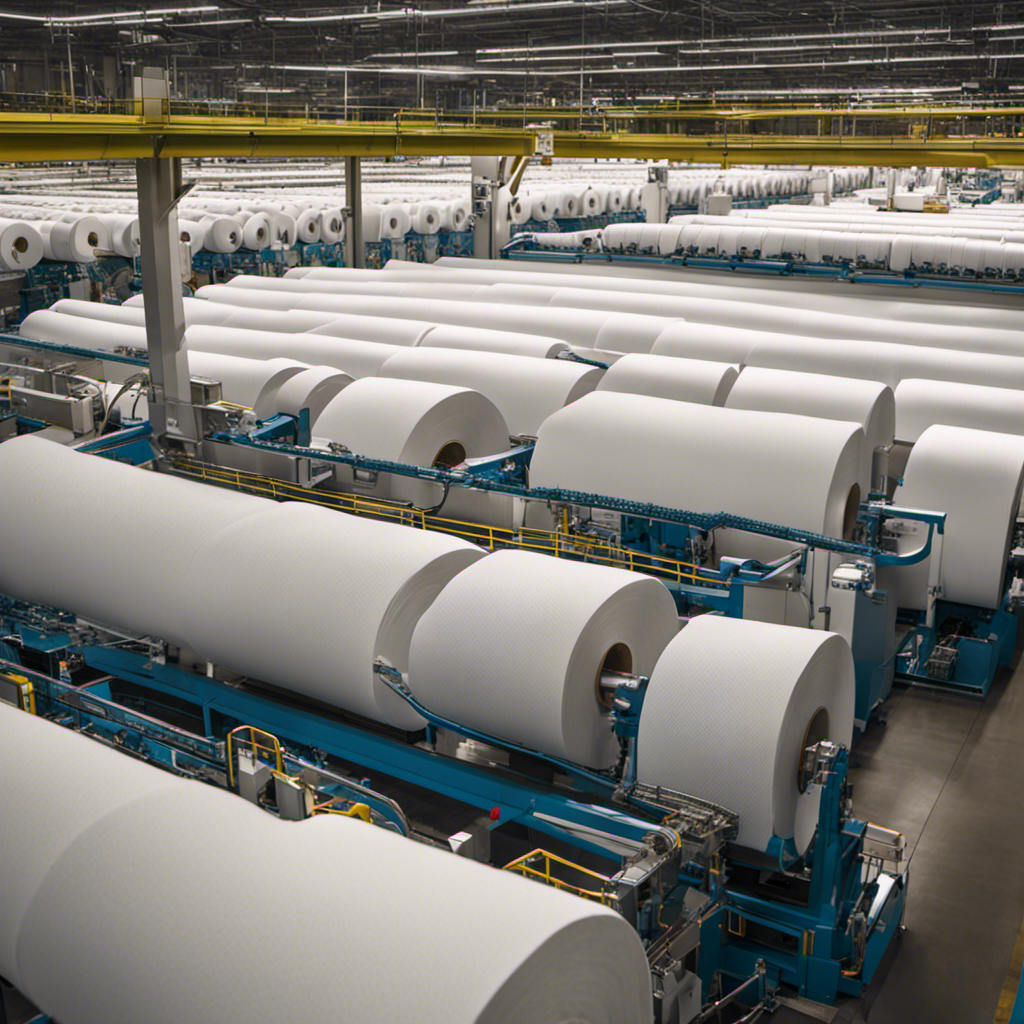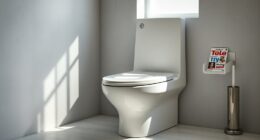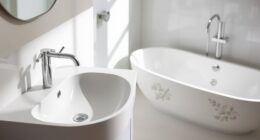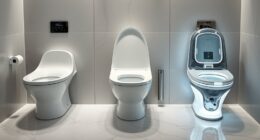Welcome to our tutorial on using a dual flush toilet! Our goal is to assist you in becoming proficient in effective flushing techniques.
In this article, we’ll provide you with step-by-step instructions, troubleshooting tips, and maintenance advice for your dual flush toilet.
Whether you’re new to this innovative technology or simply seeking to optimize your water usage, we’ve got you covered.
So, let’s dive in and discover the ins and outs of working a dual flush toilet with ease.

Key Takeaways
- Dual flush toilets have two flush options – partial flush for liquid waste and full flush for solid waste.
- Flush buttons or handles are usually located on the top or front of the toilet tank.
- Understanding the differences between full flush and half flush allows for informed choices.
- Regular maintenance is required for optimal performance of dual flush toilets.
Understanding the Dual Flush Mechanism
To understand the dual flush mechanism, we need to know how it operates and why it’s an efficient solution for water conservation. A dual flush toilet is designed with two flush options – a partial flush for liquid waste and a full flush for solid waste. The purpose of this design is to optimize water usage by providing the appropriate amount of water for each type of waste.
When the dual flush button is pressed, the partial flush option is activated, which uses a smaller amount of water, typically around 0.8 gallons. This is ideal for flushing liquid waste, as it requires less water to remove and clean the bowl. On the other hand, the full flush option, activated by pressing the other button, uses a larger amount of water, typically around 1.6 gallons. This higher volume of water is necessary to effectively flush and remove solid waste.
The dual flush mechanism offers significant water-saving benefits. By providing different flush options, it allows users to conserve water by using the appropriate flush for the waste being disposed of. This can result in substantial water savings over time, reducing both water consumption and utility costs. Additionally, the dual flush mechanism requires less maintenance compared to traditional toilets, as it’s designed to efficiently remove waste with less water, reducing the likelihood of clogs or blockages.
Locating the Flush Buttons or Handles
Now let’s talk about locating the flush buttons or handles on a dual flush toilet.
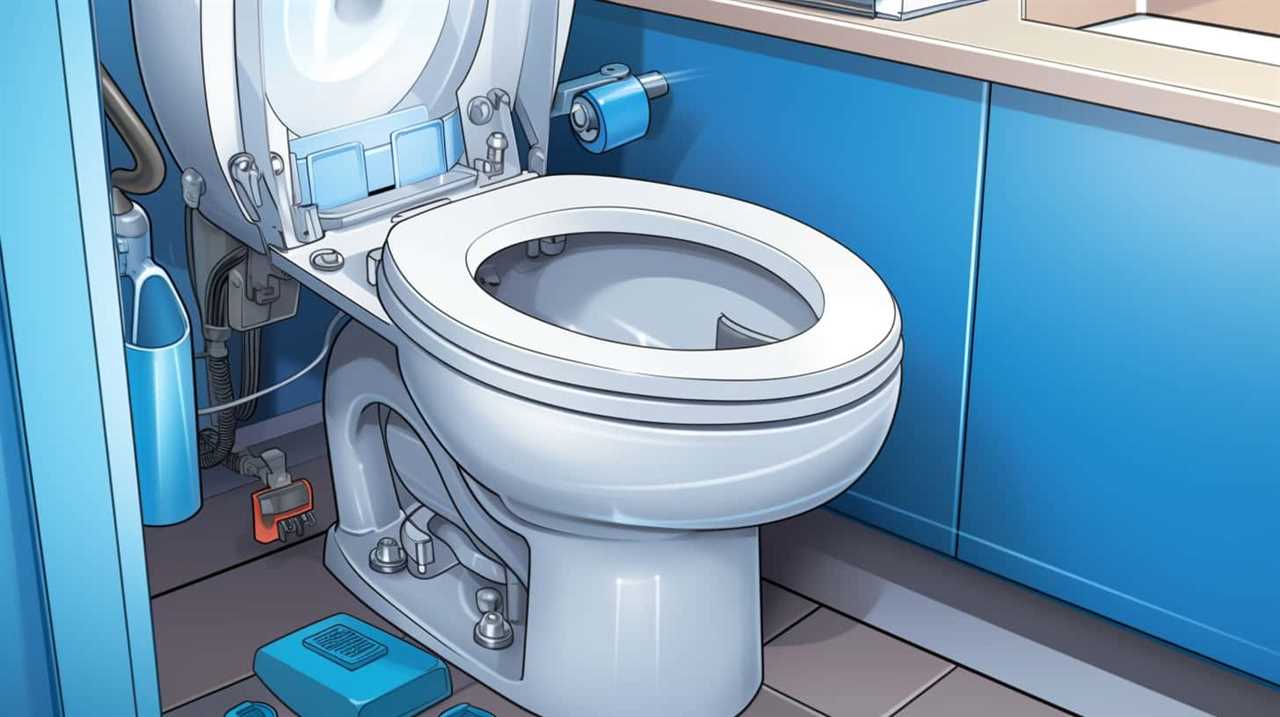
Finding the flush mechanism should be a straightforward task, as most dual flush toilets have the buttons or handles conveniently placed on the top or front of the tank.
Button or Handle Location
We locate the flush buttons or handles on a dual flush toilet by examining the design and layout of the toilet. Some dual flush toilets have buttons located on the top of the tank, while others have handles on the side. The choice between a button and a handle depends on the manufacturer’s design preferences and the user’s preferences. Both options have their benefits.
Buttons are often more modern and sleek in appearance, and they can be easier to press, requiring less effort. Handles, on the other hand, are more traditional and familiar, making them easier to use for individuals who may be unfamiliar with the button style.
Ultimately, the location of the flush buttons or handles should be intuitive and easily accessible to ensure a seamless dual flush experience.

Easily Find Flush?
How can we easily locate the flush buttons or handles on a dual flush toilet? Locating the flush options on a dual flush toilet is essential for efficient and effective use. Here are four ways to easily find the flush buttons or handles:
- Check the top of the toilet tank: Many dual flush toilets have buttons or handles conveniently placed on the top of the tank. Look for clearly labeled icons indicating the different flush options.
- Look for buttons on the wall: Some dual flush toilets have flush buttons mounted on the wall near the toilet. These buttons are usually within easy reach and clearly marked.
- Check the sides of the toilet bowl: In some models, the flush buttons or handles are located on the sides of the toilet bowl. These are typically positioned within arm’s reach and clearly labeled.
- Consult the user manual: If you’re having trouble locating the flush buttons or handles, refer to the user manual that came with the toilet. It will provide detailed instructions on the location and operation of the flush options.
Differentiating Between Full Flush and Half Flush
When using a dual flush toilet, it’s important to understand the difference between the full flush and half flush options. Distinguishing between these flush types is crucial for maximizing the benefits of dual flush toilets.
The full flush option is designed for solid waste removal and uses a higher volume of water. It provides a powerful flush that effectively clears the bowl.
On the other hand, the half flush option is meant for liquid waste and uses a reduced amount of water. This option conserves water by providing a gentler flush that’s sufficient for liquid waste removal.
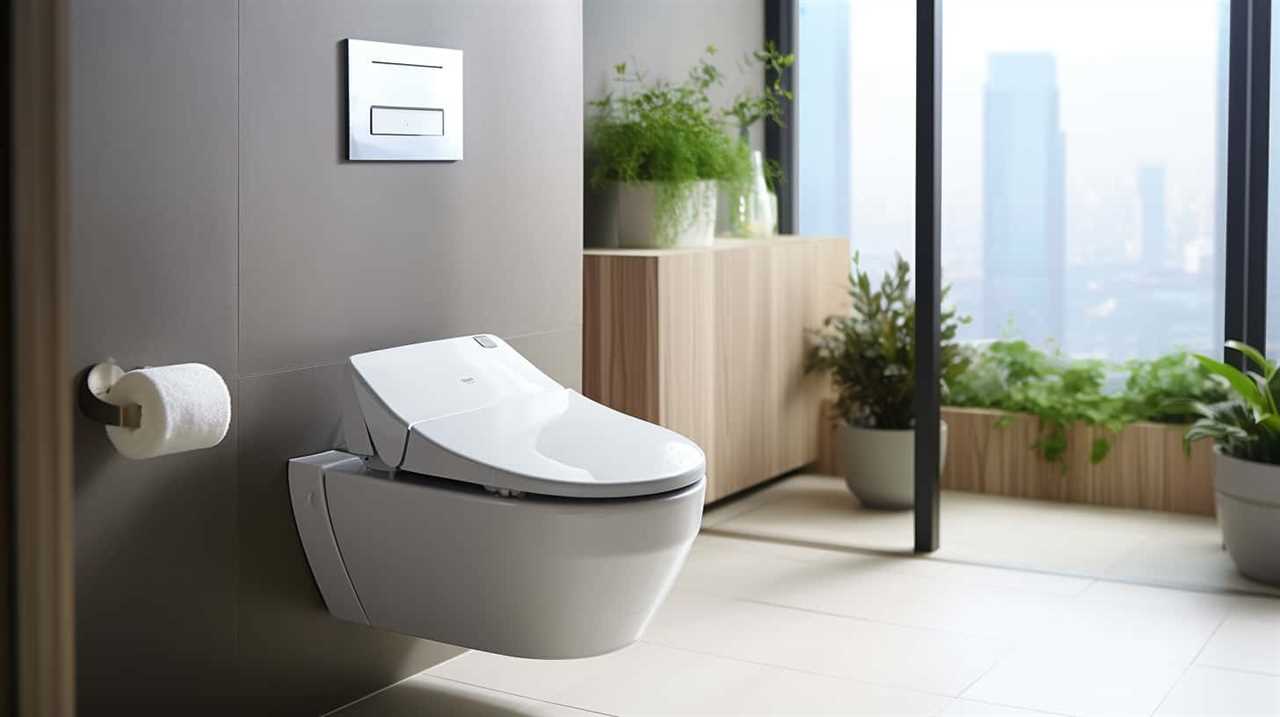
The benefits of dual flush toilets include water conservation and cost savings on water bills. By using the appropriate flush option for each type of waste, you can reduce water usage significantly. Additionally, dual flush toilets are more environmentally friendly as they contribute to the conservation of water resources.
Understanding the differences between the full flush and half flush options allows you to make informed choices when using a dual flush toilet.
Now that we know how each flush type functions, let’s move on to the next section and discuss choosing the right flush for your needs.
Choosing the Right Flush for Your Needs
To ensure optimal water conservation and waste removal, it’s important to select the appropriate flush option based on your specific needs. When choosing the right toilet, maximizing water efficiency should be a top priority. Here are four factors to consider:

- Water Usage: Different flush options consume varying amounts of water. A full flush typically uses around 1.6 gallons (6 liters) of water, while a half flush uses around 0.8 gallons (3 liters). Consider your usage patterns and the volume of waste being disposed of to determine which flush option suits your needs best.
- Waste Type: For solid waste, a full flush is usually required to ensure effective removal. However, for liquid waste, a half flush is sufficient, saving significant amounts of water. By understanding the type of waste you commonly dispose of, you can make an informed decision on which flush option to utilize.
- Frequency of Use: If the toilet is used frequently, opting for a dual flush toilet with separate buttons for full and half flushes can provide greater control over water usage. This allows you to select the appropriate flush option depending on the specific circumstances, minimizing water waste.
- Water Conservation Goals: If you prioritize water conservation, selecting a toilet with a dual flush system is essential. By utilizing the half flush option whenever possible, you can significantly reduce water consumption, helping to conserve this valuable resource.
Proper Flushing Technique for Maximum Efficiency
One key to maximizing efficiency with a dual flush toilet is using the correct flushing technique. Proper water saving techniques can help you make the most of this innovative toilet system and enjoy the benefits of dual flush toilets. To ensure optimal efficiency, it’s important to understand how to use the dual flush mechanism effectively.
When it comes to liquid waste, use the reduced flush option. This lower volume flush is designed specifically for liquid waste, utilizing less water while still effectively clearing the bowl. Simply press the smaller button or lever to activate the reduced flush, saving water with every use.
For solid waste, the full flush option should be employed. This powerful flush uses a larger volume of water to effectively remove waste, leaving the bowl clean and fresh. To activate the full flush, press the larger button or lever.
By mastering the proper flushing technique, you can save significant amounts of water with each use of your dual flush toilet. This not only benefits the environment but also reduces your water consumption and lowers your utility bills.

Now that we understand the proper flushing technique for maximum efficiency, let’s move on to the next step: adjusting the water level in the toilet tank.
Adjusting the Water Level in the Toilet Tank
To adjust the water level in the toilet tank, we’ll need to locate the water level adjustment valve. This valve is usually located on the side of the toilet fill valve, which is the mechanism responsible for refilling the tank after each flush.
Here are some steps to adjust the water level:
- Locate the water level adjustment valve on the toilet fill valve.
- Turn the valve clockwise to decrease the water level or counterclockwise to increase it.
- Flush the toilet and observe the water level in the tank.
- Make further adjustments if necessary until the water level reaches the desired height.
Adjusting the water level is important for maintaining the proper functionality of your dual flush toilet. It ensures that the water pressure is adequate for a powerful flush while also preventing any overflow issues. By adjusting the water level, you can optimize the efficiency of your toilet and save water.
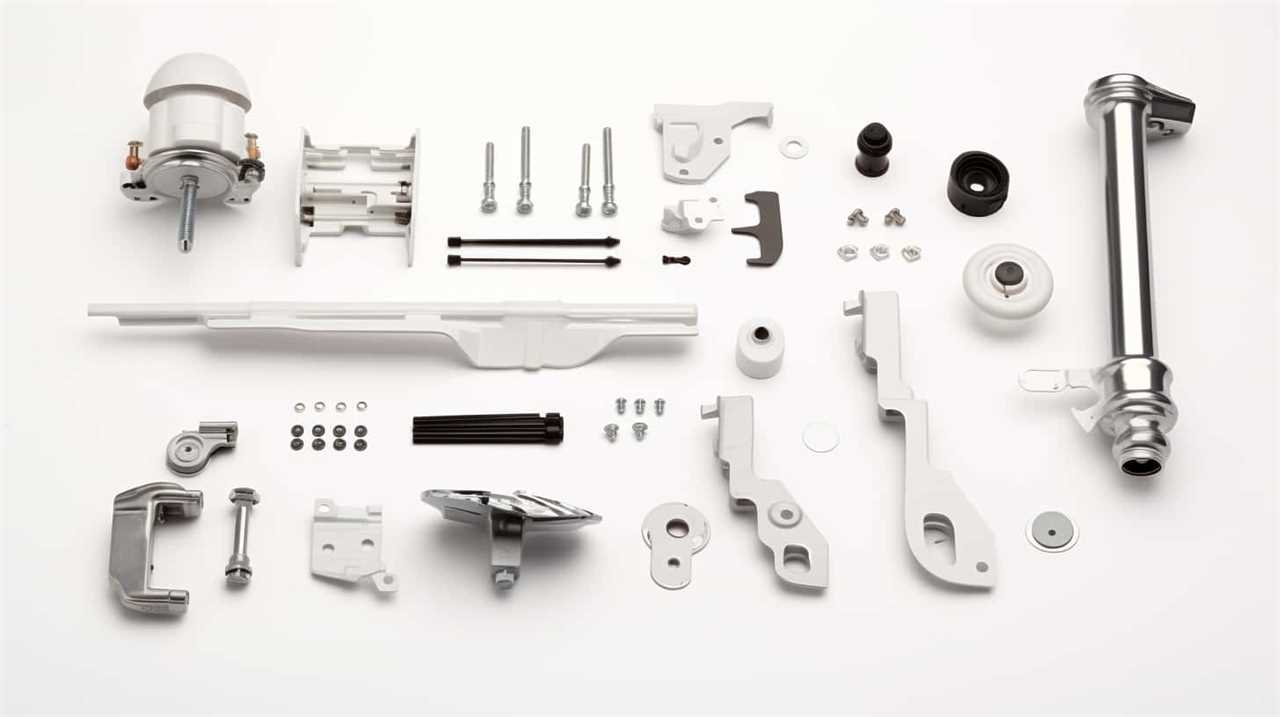
Now that we’ve discussed adjusting the water level, let’s move on to troubleshooting common dual flush toilet issues, including problems with the flush buttons and other potential malfunctions.
Troubleshooting Common Dual Flush Toilet Issues
When it comes to troubleshooting common dual flush toilet issues, there are two main points to consider: water pressure problems and flapper valve malfunction.
Low water pressure can result in weak flushes or incomplete flushing, while high water pressure can cause noisy flushing or water splashing out of the bowl.
Flapper valve malfunction can lead to continuous running or leaking of water from the tank.
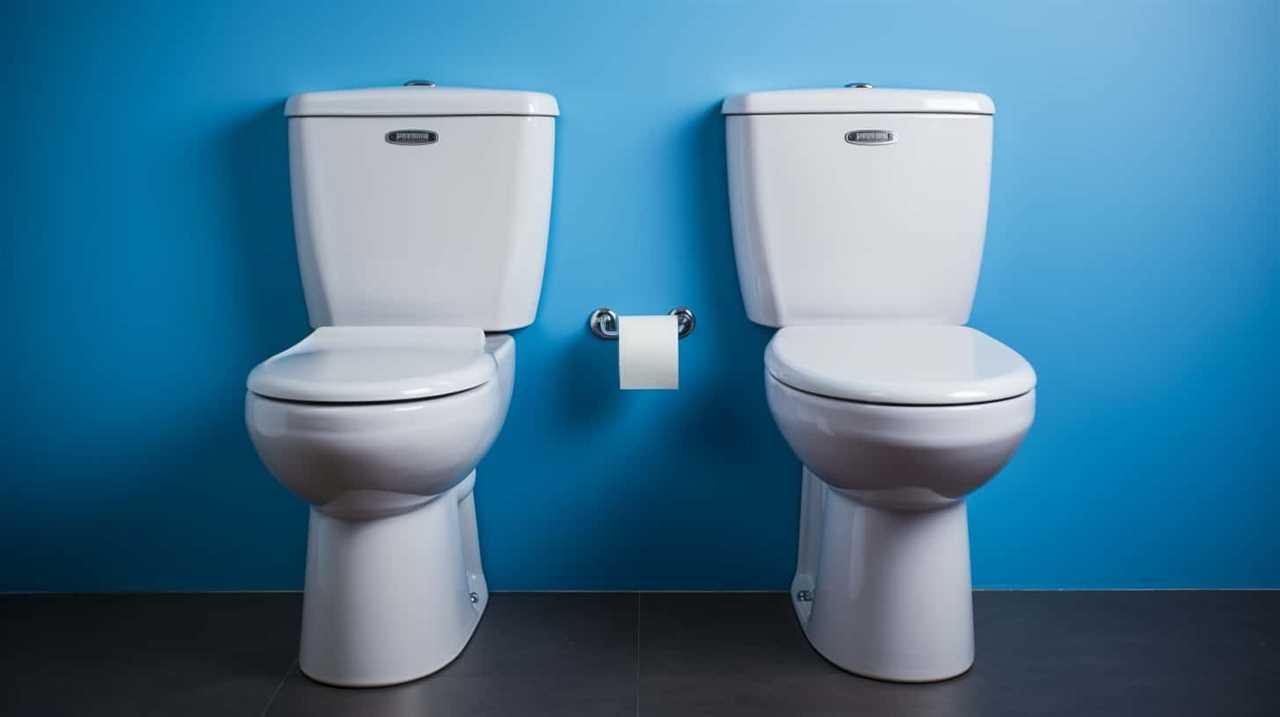
Understanding and addressing these issues can help ensure the proper functioning of your dual flush toilet.
Water Pressure Problems
We often encounter low water pressure issues when using a dual flush toilet. This can be frustrating, but there are solutions to fix the problem. Here are some tips to help you improve water pressure in your dual flush toilet:
- Check the water supply valve: Make sure it’s fully open to allow maximum water flow to the toilet.
- Clean the water inlet valve: Sediment and debris can clog the valve, reducing water pressure. Remove the valve and clean it thoroughly.
- Inspect the water supply line: A kinked or damaged supply line can restrict water flow. Replace it if necessary.
- Adjust the flush valve: The flush valve controls the amount of water released during a flush. Adjust it to increase water pressure.
Flapper Valve Malfunction
Now let’s address another common issue that can occur with dual flush toilets: a malfunctioning flapper valve.
The flapper valve is responsible for controlling the flow of water from the tank to the bowl during flushing.

When the flapper valve malfunctions, it can lead to problems such as water leakage or incomplete flushes.
To troubleshoot this issue, the first step is to check for any visible signs of damage or wear on the flapper valve.
If it appears damaged, a flapper valve replacement may be necessary.
However, if the flapper valve seems intact, it may just need an adjustment.
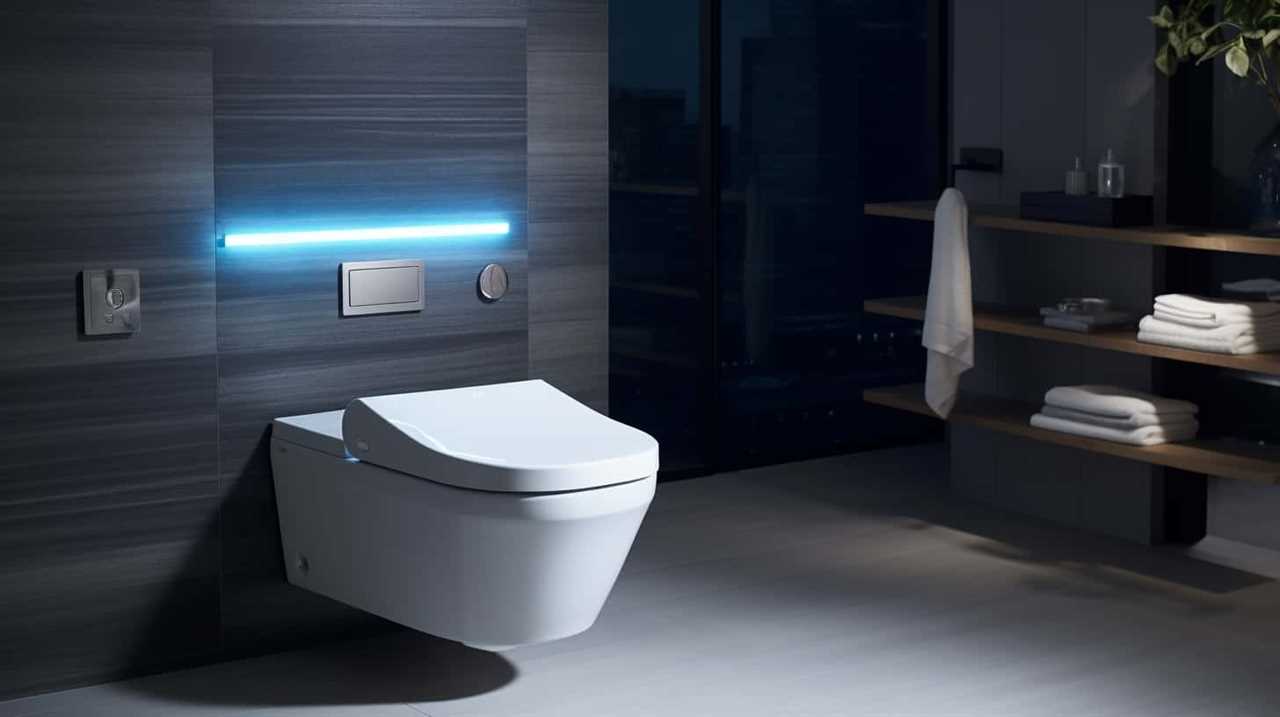
This can be done by ensuring that the flapper valve is properly aligned and making any necessary adjustments to the chain length.
Maintenance Tips for a Long-lasting Dual Flush Toilet
To ensure the longevity of our dual flush toilet, regular maintenance is crucial. By following these maintenance tips, you can prevent leaks and keep your toilet in optimal condition:
- Inspect and clean the flapper valve regularly: Check the flapper valve for any signs of wear or damage. Clean it by removing debris or mineral deposits that may affect its proper functioning.
- Check and adjust water levels: Ensure that the water level in the tank is set correctly. Adjust the water level if it’s too high or too low to prevent overflow or inadequate flushing.
- Clean the rim jets: Over time, mineral deposits can build up in the rim jets, affecting the toilet’s flush performance. Use a small brush or toothbrush to clean these jets and maintain optimal water flow.
- Check for leaks: Regularly inspect the toilet for any leaks. Look for water pooling around the base or any signs of water damage. If you detect a leak, promptly address it to prevent further damage and water wastage.
By following these maintenance tips, you can ensure that your dual flush toilet operates efficiently and lasts for years to come.
Regular upkeep won’t only save you money on water bills but also help in conserving water, making it an environmentally friendly choice.
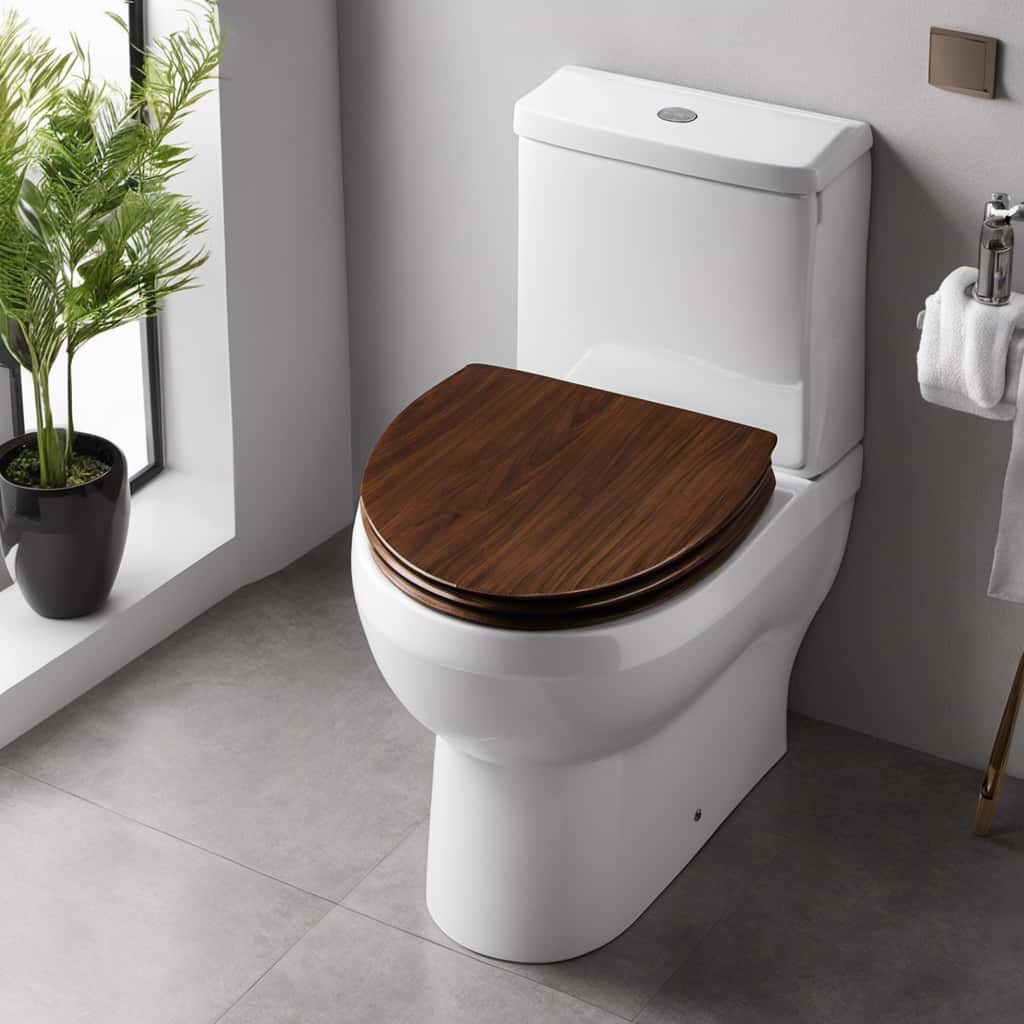
Frequently Asked Questions
What Is the History of Dual Flush Toilets?
The history of dual flush toilets is an interesting one. The development of this innovative bathroom fixture can be traced back to the need for more water-efficient options.
Over time, advancements in technology and plumbing systems led to the creation of dual flush toilets. These toilets offer users the choice between a full flush and a half flush, depending on their needs.
The history of dual flush toilets showcases the continuous efforts to conserve water and promote sustainable living.
Are Dual Flush Toilets More Expensive Than Traditional Toilets?
When it comes to the cost comparison between dual flush toilets and traditional toilets, let’s just say it’s not exactly a walk in the park.

Dual flush toilets tend to be a bit pricier upfront, but don’t let that discourage you! They can save you a ton of money in the long run by reducing your water usage.
Plus, they have a positive environmental impact by conserving water.
Can I Retrofit My Existing Toilet to Make It a Dual Flush Toilet?
When retrofitting a toilet to make it dual flush, there are a few steps to follow.
First, turn off the water supply and drain the tank.

Then, install the dual flush valve according to the manufacturer’s instructions. This valve allows you to choose between a full flush and a half flush, conserving water.
The benefits of dual flush toilets include reduced water usage and lower utility bills.
It’s a simple and cost-effective way to upgrade your existing toilet.
How Much Water Can Be Saved by Using a Dual Flush Toilet?
Water conservation benefits and the environmental impact of using a dual flush toilet are significant.

By offering two flushing options, a dual flush toilet allows us to choose a lower volume flush for liquid waste and a higher volume flush for solid waste. This targeted approach to flushing helps us save water by using only what’s necessary for each type of waste.
It reduces our overall water consumption and contributes to a more sustainable future.
Are There Any Drawbacks or Disadvantages to Using a Dual Flush Toilet?
When it comes to dual flush toilets, it’s important to consider the drawbacks and maintenance involved.
While these toilets can save a significant amount of water, there are a few potential downsides to be aware of. One interesting statistic is that dual flush toilets can reduce water usage by up to 68%.
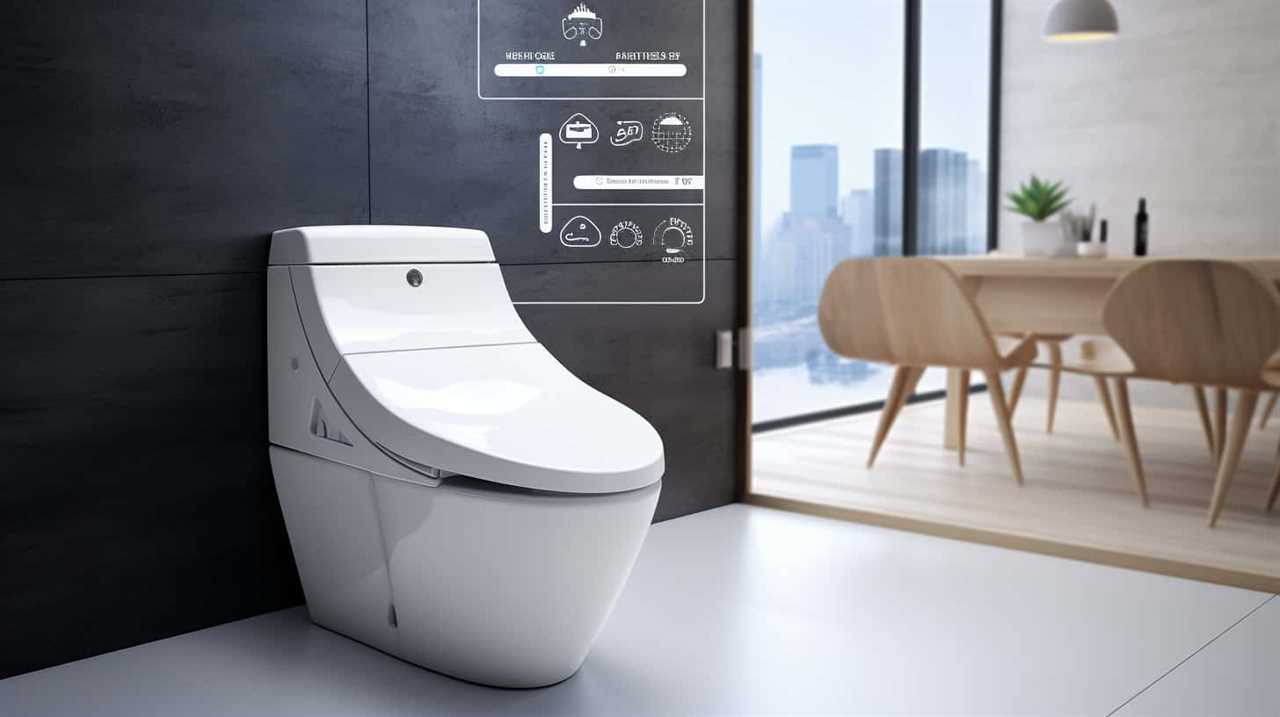
However, they may require more frequent maintenance due to the complexity of the flushing mechanism. It’s crucial to stay on top of any issues to keep your dual flush toilet working efficiently.
Conclusion
In conclusion, understanding how to work a dual flush toilet is essential for maximum efficiency and water conservation. By locating the flush buttons or handles, differentiating between full flush and half flush, and choosing the right flush for your needs, you can optimize water usage.
Proper flushing technique, adjusting the water level, and regular maintenance are also crucial. By following these steps, you can ensure a long-lasting and environmentally-friendly dual flush toilet experience.

